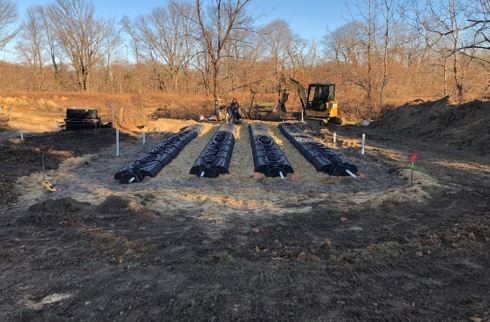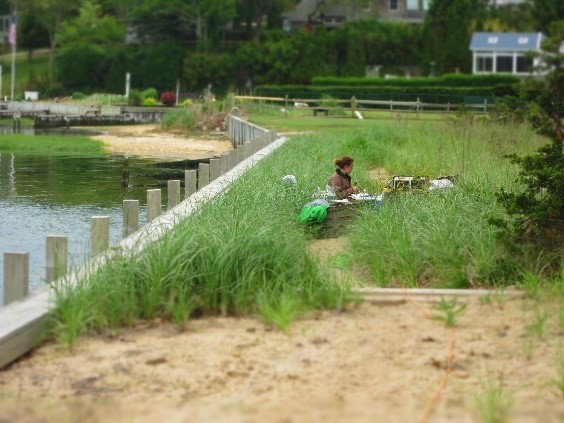Long Island Nitrogen Action Plan - April Newsletter
The New York State Department of Environmental Conservation sent this bulletin on 04/26/2019 08:30 AM EDT |
| DEC Delivers - Information to keep you connected and informed from the NYS Department of Environmental Conservation |
| Share or view as a web page || Update preferences or unsubscribe |
Long Island Nitrogen Action Plan (LINAP) - April Newsletter
|
|
In this month's issue we highlight the initiatives lead by the team at the NYS Center for Clean Water Technology (CCWT) at Stony Brook University. CCWT’s thrust is to research, develop and commercialize cost effective solutions for removing nitrogen and other contaminants of emerging concern from both drinking water and onsite wastewater. Launched in 2015, CCWT seeks to position Long Island as a leading center for innovation and development in water technology.
Nitrogen Removing BiofiltersThe Center for Clean Water Technology (CCWT) is continuing to develop non-proprietary, onsite wastewater treatment systems for residential and commercial use that reduce nitrogen to below 10 mg/L. The CCWT currently has three variations of Nitrogen Removing Biofilters (NRBs) that are adaptable to site constraints, depth to groundwater and degree of desired nitrogen removal. The basic components are an aerobic sand filter for the conversion of ammonia to nitrates followed by an anoxic (oxygen-free) environment for denitrifying bacteria to convert the nitrates to nitrogen gas that is then safely released to the atmosphere. As of April 2019, six NRBs have been placed into permanent operation, thus enrolling them in the experimental phase of Suffolk County’s Article 19 performance evaluation program which established a framework for the Department of Health Services to evaluate, approve, register, oversee and facilitate the use of innovative and alternative onsite wastewater treatment systems. The first three NRBs (installed in June 2018) are producing total nitrogen concentrations of approximately 6 mg/L. By mid-June 2019, CCWT anticipates it will have a total of 9 experimental systems enrolled in the Article 19 program. CCWT has begun to develop the next generation of NRBs. These “NextGen NRBs” are being designed to reduce the footprint dimensions of the current systems, thereby reducing the cost for installation. Testing for the Next Gen NRBs is currently underway.
New York State Wastewater Research and Innovation FacilityIn its efforts to reduce the cost of NRBs to make them affordable for the average homeowner the CCWT has constructed the New York State Wastewater Research and Innovation Facility at the location of an existing sewage pumping station. The research facility will explore passive-type wastewater treatment theories and hypotheses related to the design of the next generation of NRBs with the goal of significantly reducing the costs associated with constructing new onsite systems and for retrofitting existing septic systems. The design of the experiments has been concluded and the first grouping of experiments is scheduled to start in early-June 2019.
Constructed WetlandsThe CCWT, in collaboration with Suffolk County, is evaluating the performance of constructed wetland systems at Sylvester Manor on Shelter Island and at The Nature Conservancy Upland Farms Complex in Cold Spring Harbor. The CCWT is supplementing the baseline sampling and analysis performed by Suffolk County to develop a better understanding of how the systems function. The CCWT has also installed pilot-scale experimental wetlands at the Massachusetts Alternative Septic System Test Center to look at the levels of nitrogen removal and removal of pharmaceuticals and personal care products. CCWT has prepared a draft Wetlands Guidance Document that provides relevant information to designers and installers for the construction and maintenance of these types of onsite wastewater treatment systems. Suffolk County is currently in the process of reviewing the document for the purpose of publication. Permeable Reactive BarrierThe CCWT continues to evaluate the potential of using small-scale Permeable Reactive Barriers (PRBs) for nitrogen removal. This technology functions similarly to NRBs and are used to intercept high-nitrate groundwater before it discharges to surface water. In a pilot scale testing of a PRB installed behind a bulkhead along an estuary, the CCWT found that the PRB consistently reduced groundwater nitrogen levels by 90 percent, even in the presence of marine water intrusion. The Town of Brookhaven was recently awarded a NYSDEC grant for the installation of a PRB and the reconstruction of a bulkhead on Fire Island. CCWT assisted the Town in the preparation of the grant application and will work with the Town to install the nitrogen monitoring equipment and evaluate the performance of the PRB. This project is scheduled to start in the summer of 2019.
To sign up for the LINAP Newsletter, visit the LINAP webpage or click here. |



 CCWT PhD student Molly Graffam during field work at a bulkhead permeable reactive barrier test cell.
CCWT PhD student Molly Graffam during field work at a bulkhead permeable reactive barrier test cell.